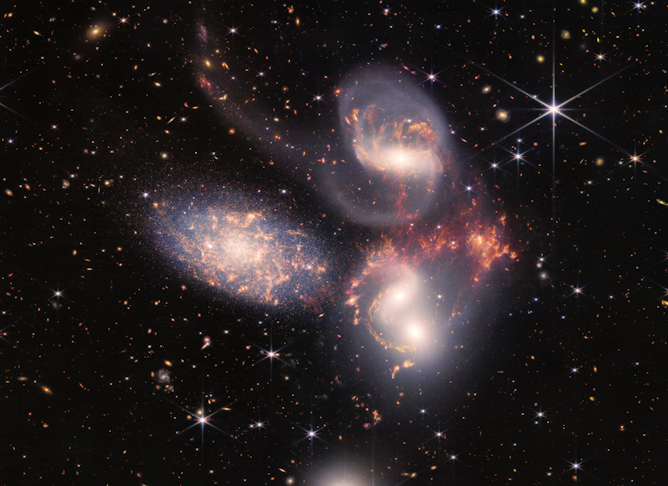|
Yesterday morning, NASA released the first images from the James Webb Space Telescope, and the scientific world is losing its collective mind.
I’d like you to take a quick pause from your busy day, take a breath and click this link to one of the newly released images captured by the James Webb Space Telescope, called Webb’s First Deep Field. And then zoom in.
That image covers a part of the night sky the size of a grain of sand held at arm’s length, yet contains thousands of galaxies. Some are bright, big and beautiful. Some are distorted as their light bends around the dense cluster of galaxies in the center of the image. And some are faint red smudges that don’t look very remarkable at first. But when you look at those small misshapen galaxies, you are looking at some of the most ancient things in existence, galaxies that formed 13 billion years ago.
The James Webb Space Telescope has been surrounded by hype, but to astronomers like Silas Laycock of the University of Massachusetts Lowell, these images show that the hype was justified. In his story, he explains what the five new images from the telescope show and why they have been bringing astronomers – and me – to tears.
Also today:
|

This cluster of galaxies, called Stephan’s Quintet, is a composite image produced from two cameras aboard the James Webb Space Telescope.
NASA/STScI
Silas Laycock, UMass Lowell
NASA released five new images from the James Webb Space Telescope, revealing incredible details of ancient galaxies, stars and the presence of water in the atmosphere of a distant planet.
|
Politics + Society
|
-
Sara Kamali, University of California Santa Barbara
A former Oath Keepers member testified during a congressional hearing that it was time to stop mincing words about the Jan. 6 assault on the U.S. Capitol: ‘It was an armed revolution.’
|
|
Ethics + Religion
|
-
David A Guba, Jr., Bard Early College Baltimore
France may be getting closer to legalizing cannabis. Still, arrests are rising quickly and often target Arab Muslim men.
|
|
Environment + Energy
|
-
Emily E. Schlickman, University of California, Davis; Brett Milligan, University of California, Davis; Stephen M. Wheeler, University of California, Davis
Communities already retreat from flooding and in the face of sea level rise. Is retreat from wildfires next, and what would that look like?
|
|
Education
|
-
Monnica Chan, UMass Boston; Preeya Pandya Mbekeani, Brown University; Zachary Mabel, Georgetown University
Some states fund their public colleges based on how well the schools perform on key metrics. New research raises questions about how that affects outcomes for students from different racial groups.
|
|
Science + Technology
|
-
Kate Ann Markey, University of Washington
Patients with blood cancer undergoing stem cell transplantation have a high risk of complications. The bacteria in their gut, however, can help their immune system recover and fight infections.
-
Tommy Shih, Lund University
Scientific research done through international collaboration has boomed in the past 30 years. But recently, powerful countries are using science as a tool of politics, threatening that work.
-
Marylynn Salmon, Smith College
The idea that Europeans brought new diseases to the Americas and returned home with others has been widely accepted. But evidence is mounting that for syphilis this scenario is wrong.
|
|